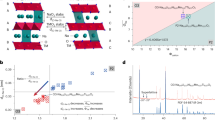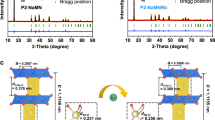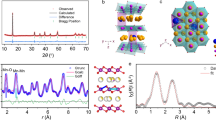Abstract
Sodium-ion batteries are among the most promising alternatives to lithium-based technologies for grid and other energy storage applications due to their cost benefits and sustainable resource supply. For the cathode—the component that largely determines the energy density of a sodium-ion battery cell—one major category of materials is P2-type layered oxides. Unfortunately, at high state-of-charge, such materials tend to undergo a phase transition with a very large volume change and consequent structural degradation during long-term cycling. Here we address this issue by introducing vacancies into the transition metal layer of P2-Na0.7Fe0.1Mn0.75□0.15O2 (‘□’ represents a vacancy). The transition metal vacancy serves to suppress migration of neighbouring Na ions and therefore maintain structural and thermal stability in Na-depleted states. Moreover, the specific Na−O−□ configuration triggers a reversible anionic redox reaction and boosts the energy density. As a result, the cathode design here enables pouch cells with energy densities of 170 Wh kg−1 and 120 Wh kg−1 that can operate for over 600 and 1,000 cycles, respectively. Our work not only suggests a feasible strategy for cathode design but also confirms the possibility of developing a battery chemistry that features a reduced need for critical raw materials.
This is a preview of subscription content, access via your institution
Access options
Access Nature and 54 other Nature Portfolio journals
Get Nature+, our best-value online-access subscription
$29.99 / 30 days
cancel any time
Subscribe to this journal
Receive 12 digital issues and online access to articles
$119.00 per year
only $9.92 per issue
Buy this article
- Purchase on Springer Link
- Instant access to full article PDF
Prices may be subject to local taxes which are calculated during checkout





Similar content being viewed by others
Data availability
The data that support the findings detailed in this study are available in the article and its Supplementary Information or from the corresponding authors on reasonable request. The X-ray crystallographic coordinates for structures reported in this study have been deposited at the Cambridge Crystallographic Data Centre (CCDC). Source data are provided with this paper.
References
Dunn, B., Kamath, H. & Tarascon, J.-M. Electrical energy storage for the grid: a battery of choices. Science 334, 928–935 (2011).
Ashish, R., Ruth, S., Christopher, J. W. & Jerry, B. Opportunities for moderate-range electric vehicles using sustainable sodium-ion batteries. Nat. Energy 8, 215–218 (2023).
Hwang, J. Y., Myung, S. T. & Sun, Y. K. Sodium-ion batteries: present and future. Chem. Soc. Rev. 46, 3529–3614 (2017).
Yabuuchi, N., Kubota, K., Dahbi, M. & Komaba, S. Research development on sodium-ion batteries. Chem. Rev. 114, 11636–11682 (2014).
Zhao, C. et al. Rational design of layered oxide materials for sodium-ion batteries. Science 370, 708–711 (2020).
Delmas, C., Carlier, D. & Guignard, M. The layered oxides in lithium and sodium‐ion batteries: a solid‐state chemistry approach. Adv. Energy Mater. 11, 2001201 (2020).
Clement, R. J., Bruce, P. G. & Grey, C. P. Review—manganese-based P2-type transition metal oxides as sodium-ion battery cathode materials. J. Electrochem. Soc. 162, A2589–A2604 (2015).
Lee, D. H., Xu, J. & Meng, Y. S. An advanced cathode for Na-ion batteries with high rate and excellent structural stability. Phys. Chem. Chem. Phys. 15, 3304 (2012).
Lu, Z. & Dahn, J. R. In situ X-ray diffraction study of P2-Na2/3[Ni1/3Mn2/3]O2. J. Electrochem. Soc. 148, A1225–A1229 (2001).
Somerville, J. W. et al. Nature of the “Z”-phase in layered Na-ion battery cathodes. Energy Environ. Sci. 12, 2223–2232 (2019).
Yabuuchi, N. et al. P2-type Nax[Fe1/2Mn1/2]O2 made from earth-abundant elements for rechargeable Na batteries. Nat. Mater. 11, 512–517 (2012).
Mortemard de Boisse, B., Carlier, D., Guignard, M., Bourgeois, L. & Delmas, C. P2-NaxMn1/2Fe1/2O2 phase used as positive electrode in Na batteries: structural changes induced by the electrochemical (de)intercalation process. Inorg. Chem. 53, 11197–11205 (2014).
Talaie, E., Duffort, V., Smith, H. L., Fultz, B. & Nazar, L. F. Structure of the high voltage phase of layered P2-Na2/3−z[Mn1/2Fe1/2]O2 and the positive effect of Ni substitution on its stability. Energy Environ. Sci. 8, 2512–2523 (2015).
Guo, S. et al. A high‐voltage and ultralong‐life sodium full cell for stationary energy storage. Angew. Chem. Int. Ed. 54, 11701–11705 (2015).
Cao, X. et al. Restraining oxygen loss and suppressing structural distortion in a newly Ti-substituted layered oxide P2-Na0.66Li0.22Ti0.15Mn0.63O2. ACS Energy Lett. 4, 2409–2417 (2019).
Liu, L. et al. High‐performance P2‐type Na2/3(Mn1/2Fe1/4Co1/4)O2 cathode material with superior rate capability for Na‐ion batteries. Adv. Energy Mater. 5, 1500944 (2015).
Clément, R. J. et al. Structurally stable Mg-doped P2-Na2/3Mn1−yMgyO2 sodium-ion battery cathodes with high rate performance: insights from electrochemical, NMR and diffraction studies. Energy Environ. Sci. 9, 3240–3251 (2016).
Singh, G. et al. High voltage Mg-doped Na0.67Ni0.3-xMgxMn0.7O2 (x = 0.05, 0.1) Na-ion cathodes with enhanced stability and rate capability. Chem. Mater. 28, 5087–5094 (2016).
Kumakura, S., Tahara, Y., Sato, S., Kubota, K. & Komaba, S. P’2-Na2/3Mn0.9Me0.1O2 (Me = Mg, Ti, Co, Ni, Cu, and Zn): correlation between orthorhombic distortion and electrochemical property. Chem. Mater. 29, 8958–8962 (2017).
Yoshida, J. et al. New P2-Na0.70Mn0.60Ni0.30Co0.10O2 layered oxide as electrode material for Na-ion batteries. J. Electrochem. Soc. 161, A1987–A1991 (2014).
Tapia-Ruiz, N. et al. High voltage structural evolution and enhanced Na-ion diffusion in P2-Na2/3Ni1/3−xMgxMn2/3O2 (0 ≤ x ≤ 0.2) cathodes from diffraction, electrochemical and ab initio studies. Energy Environ. Sci. 11, 1470–1479 (2018).
Casas-Cabanas, M., Reynaud, M., Rikarte, J., Horbach, P. & Rodríguez-Carvajal, J. FAULTS: a program for refinement of structures with extended defects. J. Appl. Crystallogr. 49, 2259–2269 (2016).
Yabuuchi, N. et al. New O2/P2‐type Li‐excess layered manganese oxides as promising multi‐functional electrode materials for rechargeable Li/Na batteries. Adv. Energy Mater. 4, 1301453 (2014).
Wang, Q. C. et al. Tuning sodium occupancy sites in P2‐layered cathode material for enhancing electrochemical performance. Adv. Energy Mater. 11, 2003455 (2021).
Shiyong, C. et al. Pinning effect enhanced structural stability toward a zero-strain layered cathode for sodium-ion batteries. Angew. Chem. Int. Ed. 60, 13366–13371 (2021).
Iwnetim, I. A. et al. Coulombically-stabilized oxygen hole polarons enable fully reversible oxygen redox. Energy Environ. Sci. 14, 4858–4867 (2021).
Li, Y. et al. Native vacancy enhanced oxygen redox reversibility and structural robustness. Adv. Energy Mater. 9, 1803087 (2018).
Kumakura, S., Tahara, Y., Kubota, K., Chihara, K. & Komaba, S. Sodium and manganese stoichiometry of P2‐type Na2/3MnO2. Angew. Chem. Int. Ed. 55, 12760–12763 (2016).
House, R. A. et al. What triggers oxygen loss in oxygen redox cathode materials? Chem. Mater. 31, 3293–3300 (2019).
Boivin, E., House, R. A., Marie, J. J. & Bruce, P. G. Controlling iron versus oxygen redox in the layered cathode Na0.67Fe0.5Mn0.5O2: mitigating voltage and capacity fade by Mg substitution. Adv. Energy Mater. 12, 2200702 (2022).
Jaeseong, H. et al. Lattice‐oxygen‐stabilized Li‐ and Mn‐rich cathodes with sub‐micrometer particles by modifying the excess‐Li distribution. Adv. Mater. 33, 2100352 (2021).
Parant, J.-P., Olazcuaga, R., Devalette, M., Fouassier, C. & Hagenmuller, P. Sur quelques nouvelles phases de formule NaxMnO2 (x ⩽ 1). J. Solid State Chem. 3, 1–11 (1971).
Li, Q. et al. Improving the oxygen redox reversibility of Li-rich battery cathode materials via Coulombic repulsive interactions strategy. Nat. Commun. 13, 1123 (2022).
Sharpe, R. et al. Redox chemistry and the role of trapped molecular O2 in Li-rich disordered rocksalt oxyfluoride cathodes. J. Am. Chem. Soc. 142, 21799–21809 (2020).
House, R. A. et al. Superstructure control of first-cycle voltage hysteresis in oxygen-redox cathodes. Nature 577, 502–508 (2020).
Eum, D. et al. Voltage decay and redox asymmetry mitigation by reversible cation migration in lithium-rich layered oxide electrodes. Nat. Mater. 19, 419–427 (2020).
Lee, E. & Persson, K. A. Structural and chemical evolution of the layered Li‐excess LixMnO3 as a function of Li content from first‐principles calculations. Adv. Energy Mater. 4, 1400498 (2014).
Cao, X., Qiao, Y., Jia, M., He, P. & Zhou, H. Ion-exchange: a promising strategy to design Li-rich and Li-excess layered cathode materials for Li-ion batteries. Adv. Energy Mater. 12, 2003972 (2021).
Maitra, U. et al. Oxygen redox chemistry without excess alkali-metal ions in Na2/3[Mg0.28Mn0.72]O2. Nat. Chem. 10, 288–295 (2018).
Farrow, C. L. et al. PDFfit2 and PDFgui: computer programs for studying nanostructure in crystals. J. Phys. Condens. Matter 19, 335219 (2007).
Kresse, G. & Furthmüller, J. Efficient iterative schemes for ab initio total-energy calculations using a plane-wave basis set. Phys. Rev. B 54, 11169–11186 (1996).
Kresse, G. & Furthmüller, J. Efficiency of ab-initio total energy calculations for metals and semiconductors using a plane-wave basis set. Comput. Mater. Sci. 6, 15–50 (1996).
Blöchl, P. E. Projector augmented-wave method. Phys. Rev. B 50, 17953–17979 (1994).
Perdew, J. P. & Burke, K. Generalized gradient approximation made simple. Phys. Rev. Lett. 77, 3865–3868 (1996).
Anisimov, V. I., Zaanen, J. & Andersen, O. K. Band theory and Mott insulators: Hubbard U instead of Stoner I. Phys. Rev. B 44, 943–954 (1991).
Dudarev, S. L., Botton, G. A., Savrasov, S. Y., Humphreys, C. J. & Sutton, A. P. Electron-energy-loss spectra and the structural stability of nickel oxide: an LSDA+U study. Phys. Rev. B 57, 1505–1509 (1998).
Wang, L., Maxisch, T. & Ceder, G. Oxidation energies of transition metal oxides within the GGA+U framework. Phys. Rev. B 73, 195107 (2006).
Jinnouchi, R., Lahnsteiner, J., Karsai, F., Kresse, G. & Bokdam, M. Phase transitions of hybrid perovskites simulated by machine-learning force fields trained on the fly with Bayesian inference. Phys. Rev. Lett. 122, 225701 (2019).
Jinnouchi, R., Karsai, F. & Kresse, G. On-the-fly machine learning force field generation: application to melting points. Phys. Rev. B 100, 014105 (2019).
Jinnouchi, R., Karsai, F., Verdi, C., Asahi, R. & Kresse, G. Descriptors representing two- and three-body atomic distributions and their effects on the accuracy of machine-learned inter-atomic potentials. J. Chem. Phys. 152, 234102 (2020).
Swope, W. C., Andersen, H. C., Berens, P. H. & Wilson, K. R. A computer simulation method for the calculation of equilibrium constants for the formation of physical clusters of molecules: application to small water clusters. J. Chem. Phys. 76, 637–649 (1982).
Hoover, W. G. Canonical dynamics: equilibrium phase-space distributions. Phys. Rev. A 31, 1695–1697 (1985).
Schüth, F. Chemistry of Materials—your journal for high science in 2012. Chem. Mater. 24, 1–2 (2012).
Pan, H. et al. Alkali‐ion storage behaviour in spinel lithium titanate electrodes. ChemElectroChem 2, 1678–1681 (2015).
Zhang, H. et al. Titration mass spectroscopy (TMS): a quantitative analytical technology for rechargeable batteries. Nano Lett. 22, 9972–9981 (2022).
Acknowledgements
This work was partially supported by the National Natural Science Foundation of China (grants 22021001, 22179111, 22109186, 22272022, 52122211 and 52072323), the Ministry of Science and Technology of China (grants 2023YFB2406200 and 2021YFA1201900), the Basic Research Program of Tan Kah Kee Innovation Laboratory (grant RD2021070401), the Principal Fund from Xiamen University (grant 20720210015), the Fundamental Research Funds for the Central Universities (grant 20720220010) and the Beijing Natural Science Foundation (grant Z190010). This research used resources of the Advanced Photon Source, a US Department of Energy (DOE) Office of Science User Facility operated for the DOE Office of Science by Argonne National Laboratory under contract DE-AC02-06CH11357. G.-L.X. and K.A. thank the Clean Vehicle Consortium, US–China Clean Energy Research Centre (CERC-CVC2) for support. Part of this work was conducted at the NOMAD beamline at the Spallation Neutron Source, Oak Ridge National Laboratory, which is sponsored by the Scientific User Facilities Division, Office of Basic Sciences, US Department of Energy. This research also employed the resources of the Shanghai Synchrotron Radiation Facility BL02B02, BL11B, BL14B1 and BL14W1 beamline stations (SSRF, under contracts 2021-SSRF-PT-017208, 2022-SSRF-PT-019758, 2022-SSRF-PT-021637 and 2023-SSRF-ZD-503448); beamlines MCD-A and MCD-B (Soochow Beamline for Energy Materials) at Hefei National Synchrotron Radiation Laboratory (NSRL-USTC, under contracts 2021-HLS-PT-004529, 2021-HLS-PT-004156 and 2021-HLS-PT-004241); Beijing Synchrotron Radiation Laboratory 1W1A, 1W1B, 3W1, 4B9A and 4B9B beamline stations (under contracts 2021-BEPC-PT-005771, 2021-BEPC-PT-005765, 2021-BEPC-PT-005760 and 2022-BEPC-PT-006478) and Multi-Physics Instrument at China Spallation Neutron Source (MPI, CSNS, under contracts P1621080200036 and P1621122000008). We appreciate the help from D. Wong, C. Schulz and M. Bartkowiak for the RIXS characterization (proposal-Info: 221-11099-ST) at beamline U41-PEAXIS of Bessy II, Helmholtz-Zentrum Berlin für Materialien und Energie (HZB), Berlin, Germany. We thank W. He (Chimie du Solide-Energie, Collège de France, France), S. Yang (Department of Materials, University of Oxford, U.K.), L. Pan (Hokkaido University, Japan), H. Li (University of Illinois at Chicago, USA) and J. Serrano Sevillano (CIC Energi Gune, Spain) for their help and discussion on in situ XRD, OEMS, Moss, nPDF characterizations and FAULTS programme.
Author information
Authors and Affiliations
Contributions
Y.T. and Y. Qiao contributed to the design of the research and performed the experimental data analysis. Y.T. conducted the materials synthesis, electrochemistry and cell performance. Qinghua Zhang and L.G. conducted the STEM experiments and related data analysis. W.Z. and L.Z. conducted the hard-XAS experiments with the help of I.H. and C.-J.S. Y.T. conducted the analysis of XAS results with the help of L.Z., G.-L.X. and K.A. B.Z. and G.Z. helped to conduct the XRD experiment and FAULTS simulation. Z.H., J.X., Y. Qiu, W.Y. and Y.X. conducted the NPD/nPDF experiments and related data analysis. H.Z. conducted the in situ heated MS experiments. T.Z. and S.Z. conducted the in situ heated TEM experiments and related data analysis with the help of Qiaobao Zhang and H.-G.L. Q.W. conducted the RIXS experiments and related data analysis. Y.S. conducted the theoretical calculation and related data analysis. Y. Qiao conducted the analysis of Fe-MS characterizations. Q.W., Y.S., G.-L.X., L.G., Y. Qiao and S.-G.S. supervised the work. All authors discussed the results, co-wrote and commented on the manuscript.
Corresponding authors
Ethics declarations
Competing interests
The authors declare no competing interests.
Peer review
Peer review information
Nature Sustainability thanks Dong-Hwa Seo, William Chueh and the other, anonymous, reviewer(s) for their contribution to the peer review of this work.
Additional information
Publisher’s note Springer Nature remains neutral with regard to jurisdictional claims in published maps and institutional affiliations.
Extended data
Extended Data Fig. 1 Charge compensation mechanism and TM − O coordination environment analysis of NFMOs.
a, X-ray absorption near edge structure (XANES) of the Fe K-edge (left) and Mn K-edge (right) of VC-NFMO collected at different states of charge/discharge; Fe2+/Fe3+ and Mn2+/Mn3+/Mn4+ standard spectra are shown at the bottom for comparison. b, Fourier transforms (FTs) of the Fe K-edge (left) and Mn K-edge (right) EXAFS spectra of VC-NFMO collected at different states of charge/discharge. The spectra have been offset for clear visibility, and the EXAFS spectra (Fe and Mn) collected in the OCV state have also been offset and overlaid as grey dashed lines for comparison. c, Redox state analysis of VF-NFMO (grey) and VC-NFMO (blue) in various charge/discharge states. The average edge position is fitted by the integral method. The Fe K-edge (top) and Mn K-edge (bottom) edge positions are directly fitted for the corresponding XANES edge regions shown in Supplementary Fig. 18 and (a). d, EXAFS fitting results of VF-NFMO (grey) and VC-NFMO (blue) in various charge/discharge states. The TM − O and TM − TM distances of the Fe K-edge (top) and Mn K-edge (bottom) are fitted for the corresponding FT EXAFS regions shown in Supplementary Fig. 20 and (b). The error bars represent the error range during EXAFS fitting and the precise values are given in Supplementary Tables 12–13. e, Wavelet transform (WT)-EXAFS differential spectra of the Fe-K edge of both VF-NFMO (left) and VC-NFMO (right) between the OCV and 4.5 V. The change from purple to red indicates a greater difference in the Fe K-edge. f, Schematic of the TM − O/TM − TM covalent structural distortion induced by the P-to-O phase transition in VF-NFMO.
Extended Data Fig. 2 Structural, morphological, and gas evolution of the charged cathodes at high temperatures.
a, Schematic of the charged P2-type cathode characterized by in situ XRD, MS, and TEM under thermal runaway simulation. b,c, Results of in situ XRD and online electrochemical mass spectrometry (OEMS) of the 4.5 V-charged (b) VF-NFMO and (c) VC-NFMO cathode plates upon heating from room temperature to 400 °C at 5 °C min−1. d,e, SAED patterns of the (d) VF-NFMO and (e) VC-NFMO cathode powders scraped from the 4.5 V-charged cathode plates during heating from room temperature to 400 °C at 2 °C s−1. Scale bars, 5 nm−1.
Supplementary information
Supplementary Information
Supplementary Figs. 1−28, Tables 1−14 and Notes 1 and 2.
Supplementary Video 1
In situ selected area electron diffraction (SAED) of the 4.5 V charged VF-NFMO during heating from room temperature to 400 °C at 2 °C s–1 (displayed with a speed ×10 of a real-time process).
Supplementary Video 2
In situ SAED of the 4.5 V charged VC-NFMO during heating from room temperature to 400 °C at 2 °C s–1 (displayed with a speed ×30 of a real-time process).
Supplementary Video 3
In situ transmission electron microscope (TEM) of the 4.5 V charged VC-NFMO upon heating from room temperature to 700 °C at 2 °C s–1 (displayed with a speed ×30 of a real-time process).
Supplementary Video 4
In situ TEM of the 4.5 V charged VF-NFMO upon heating from room temperature to 700 °C at 2 °C s–1 (displayed with a speed ×10 of a real-time process).
Source data
Source Data Fig. 1
FAULTS simulations results.
Source Data Fig. 2
Structure characterization results.
Source Data Fig. 3
Structural evolution characterization results.
Source Data Fig. 4
Machine learning-aided ab initio molecular dynamics simulations.
Source Data Fig. 5
Electrochemical results.
Source Data Extended Data Fig. 1
X-ray absorption spectrum results.
Source Data Extended Data Fig. 2
Structural evolution under thermal runaway.
Rights and permissions
Springer Nature or its licensor (e.g. a society or other partner) holds exclusive rights to this article under a publishing agreement with the author(s) or other rightsholder(s); author self-archiving of the accepted manuscript version of this article is solely governed by the terms of such publishing agreement and applicable law.
About this article
Cite this article
Tang, Y., Zhang, Q., Zuo, W. et al. Sustainable layered cathode with suppressed phase transition for long-life sodium-ion batteries. Nat Sustain 7, 348–359 (2024). https://doi.org/10.1038/s41893-024-01288-9
Received:
Accepted:
Published:
Issue Date:
DOI: https://doi.org/10.1038/s41893-024-01288-9
This article is cited by
-
Freedom of chemical space
Nature Sustainability (2024)



